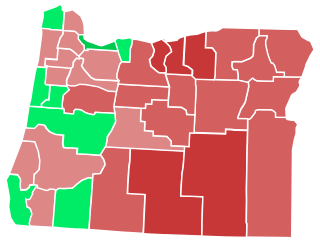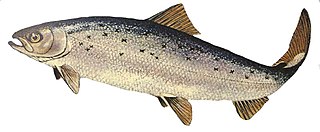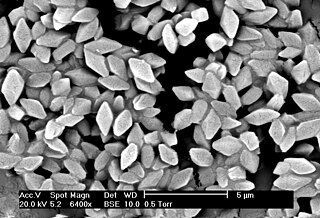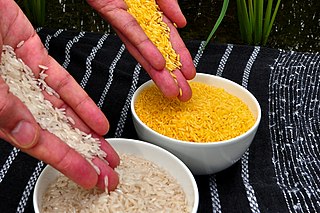 W
WOregon Ballot Measure 92 was a ballot measure in the U.S. state of Oregon to determine whether or not to enact a "law requiring the labeling of genetically engineered foods produced and sold in Oregon". Measure 92 was close enough to trigger a recount, and ultimately did not pass with 50.3% of the state voting against labeling GMOs.
 W
WAmflora is a genetically modified potato cultivar developed by BASF Plant Science. "Amflora" potato plants produce pure amylopectin starch that is processed to waxy potato starch. It was approved for industrial applications in the European Union on 2 March 2010 by the European Commission. In January 2012, the potato was withdrawn from the market in the EU.
 W
WAquAdvantage salmon is a genetically engineered (GE) Atlantic salmon developed by AquaBounty Technologies in 1989. The typical growth hormone-regulating gene in the Atlantic salmon was replaced with the growth hormone-regulating gene from Pacific Chinook salmon, with a promoter sequence from ocean pout. This gene enables the GM salmon to grow year-round instead of only during spring and summer.
 W
WBacillus thuringiensis is a Gram-positive, soil-dwelling bacterium, the most commonly used biological pesticide worldwide. B. thuringiensis also occurs naturally in the gut of caterpillars of various types of moths and butterflies, as well on leaf surfaces, aquatic environments, animal feces, insect-rich environments, and flour mills and grain-storage facilities. It has also been observed to parasitize other moths such as Cadra calidella—in laboratory experiments working with C. calidella, many of the moths were diseased due to this parasite.
 W
WBlue tomatoes, sometimes referred to as purple tomato, are tomatoes that have been bred to produce high levels of anthocyanins, a class of pigments responsible for the blue and purple colours of many fruits, including blueberries, blackberries and chokeberries. Anthocyanins may provide protection for the plant against insects, diseases, and ultraviolet radiation. Some of these tomatoes have been commercialized under the names "Indigo Rose" and "SunBlack".
 W
WGenetically modified food controversies are disputes over the use of foods and other goods derived from genetically modified crops instead of conventional crops, and other uses of genetic engineering in food production. The disputes involve consumers, farmers, biotechnology companies, governmental regulators, non-governmental organizations, and scientists. The key areas of controversy related to genetically modified food are whether such food should be labeled, the role of government regulators, the objectivity of scientific research and publication, the effect of genetically modified crops on health and the environment, the effect on pesticide resistance, the impact of such crops for farmers, and the role of the crops in feeding the world population. In addition, products derived from GMO organisms play a role in the production of ethanol fuels and pharmaceuticals.
 W
WDhara Mustard Hybrid-11, otherwise known as DMH - 11, is a genetically modified hybrid variety of the mustard species Brassica juncea. It was developed by Professor Deepak Pental from the University of Delhi, with the aim of reducing India's demand for edible oil imports. DMH - 11 was created through transgenic technology, primarily involving the Bar, Barnase and Barstar gene system. The Barnase gene confers male sterility, while the Barstar gene restores DMH - 11's ability to produce fertile seeds. The insertion of the third gene Bar, enables DMH - 11 to produce phosphinothricin-N- acetyl-transferase, the enzyme responsible for Glufosinate resistance. This hybrid mustard variety has come under intense public scrutiny, mainly due to concerns regarding DMH - 11's potential to adversely affect the environment as well as consumer health. DMH - 11 was found not to pose any food allergy risks, and has demonstrated increased yields over existing mustard varieties. Conflicting details and results regarding the field trials and safety evaluations conducted on DMH - 11 have delayed its approval for commercial cropping.
 W
WJon Entine is an American science journalist. After working as a network news writer and producer for NBC News and ABC News, Entine moved into print journalism. Entine has written seven books and is a contributing columnist to newspapers and magazines. He is the founder and executive director of the science advocacy group the Genetic Literacy Project, and a former visiting scholar at the American Enterprise Institute. He is also the founder of the consulting company ESG Mediametrics.
 W
WGenetically modified crops are plants used in agriculture, the DNA of which has been modified using genetic engineering methods. Plant genomes can be engineered by physical methods or by use of Agrobacterium for the delivery of sequences hosted in T-DNA binary vectors. In most cases, the aim is to introduce a new trait to the plant which does not occur naturally in the species. Examples in food crops include resistance to certain pests, diseases, environmental conditions, reduction of spoilage, resistance to chemical treatments, or improving the nutrient profile of the crop. Examples in non-food crops include production of pharmaceutical agents, biofuels, and other industrially useful goods, as well as for bioremediation.
 W
WGenetically modified foods, also known as genetically engineered foods, or bioengineered foods are foods produced from organisms that have had changes introduced into their DNA using the methods of genetic engineering. Genetic engineering techniques allow for the introduction of new traits as well as greater control over traits when compared to previous methods, such as selective breeding and mutation breeding.
 W
WGenetically modified food crops were introduced into Ghana in 2013. GM crops are controversial around the world for various reasons and Ghana is no exception. Groups against its introduction include: Food Sovereignty Ghana, The Coalition For Farmer’s Rights, Advocacy Against GMOs, Ghana Catholic Bishops’ Conference, and the Convention People’s Party. They argue that genetically modified food is not conducive to good health, and is neo-colonialist in nature. That is, it hands control of the food supply to rich nations, which threatens food sovereignty and the national interest,
 W
WThe papaya, papaw, or pawpaw is the plant Carica papaya, one of the 22 accepted species in the genus Carica of the family Caricaceae. Its origin is in the tropics of the Americas, perhaps from Central America and southern Mexico.
 W
WGenetically modified plants have been engineered for scientific research, to create new colours in plants, deliver vaccines, and to create enhanced crops. Plant genomes can be engineered by physical methods or by use of Agrobacterium for the delivery of sequences hosted in T-DNA binary vectors. Many plant cells are pluripotent, meaning that a single cell from a mature plant can be harvested and then under the right conditions form a new plant. This ability can be taken advantage of by genetic engineers; by selecting for cells that have been successfully transformed in an adult plant a new plant can then be grown that contains the transgene in every cell through a process known as tissue culture.
 W
WA genetically modified potato is a potato that has had its genes modified, using genetic engineering. Goals of modification include introducing pest resistance, tweaking the amounts of certain chemicals produced by the plant, and to prevent browning or bruising of the tubers. Varieties modified to produce large amounts of starches may be approved for industrial use only, not for food.
 W
WGenetically modified rice are rice strains that have been genetically modified. Rice plants have been modified to increase micronutrients such as vitamin A, accelerate photosynthesis, tolerate herbicides, resist pests, increase grain size, generate nutrients, flavours or produce human proteins.
 W
WA genetically modified soybean is a soybean that has had DNA introduced into it using genetic engineering techniques. In 1996 the first genetically modified soybean was introduced to the U.S. market, by Monsanto. In 2014, 90.7 million hectares of GM soy were planted worldwide, 82% of the total soy cultivation area.
 W
WA genetically modified tomato, or transgenic tomato, is a tomato that has had its genes modified, using genetic engineering. The first trial genetically modified food was a tomato engineered to have a longer shelf life, but never made it to market. The first direct consumption tomato was approved in Japan in 2021. Primary work is focused on developing tomatoes with new traits like increased resistance to pests or environmental stresses. Other projects aim to enrich tomatoes with substances that may offer health benefits or be more nutritious. As well as aiming to produce novel crops, scientists produce genetically modified tomatoes to understand the function of genes naturally present in tomatoes.
 W
WGolden rice is a variety of rice produced through genetic engineering to biosynthesize beta-carotene, a precursor of vitamin A, in the edible parts of rice. It is intended to produce a fortified food to be grown and consumed in areas with a shortage of dietary vitamin A. Vitamin A deficiency causes xerophthalmia, a range of eye conditions from night blindness to more severe clinical outcomes such as keratomalacia and corneal scars, and permanent blindness. It also increases risk of mortality from measles and diarrhea in children. In 2013, the prevalence of deficiency was the highest in sub-Saharan Africa, and South Asia.
 W
WLet Them Eat Precaution: How Politics is Undermining the Genetic Revolution in Agriculture is a 2005 book edited by American author and journalist Jon Entine, about how politics is affecting the use of genetically modified food. The 10 contributing authors from the United States and the United Kingdom provide insights into the benefits of agricultural biotechnology, offer an international perspective on why some groups are opposed to it, and suggest potential solutions to the controversy.
 W
WMonsanto Canada Inc v Schmeiser [2004] 1 S.C.R. 902, 2004 SCC 34 is a leading Supreme Court of Canada case on patent rights for biotechnology, between a Canadian canola farmer, Percy Schmeiser, and the agricultural biotechnology company Monsanto. The court heard the question of whether Schmeiser's intentionally growing genetically modified plants constituted "use" of Monsanto's patented genetically modified plant cells. By a 5-4 majority, the court ruled that it did. The Supreme Court also ruled 9-0 that Schmeiser did not have to pay Monsanto their technology use fee, damages or costs, as Schmeiser did not receive any benefit from the technology. The case drew worldwide attention and is widely misunderstood to concern what happens when farmers' fields are accidentally contaminated with patented seed. However, by the time the case went to trial, all claims of accidental contamination had been dropped; the court only considered the GM canola in Schmeiser's fields, which Schmeiser had intentionally concentrated and planted. Schmeiser did not put forward any defence of accidental contamination.
 W
WThe Monsanto Years is a studio album by Canadian singer-songwriter Neil Young and the American rock group Promise of the Real, released on June 29, 2015 on Reprise Records. A concept album which criticizes the agribusiness company Monsanto, it is Young's thirty-fifth studio album and the third by Promise of the Real. The group is fronted by Willie Nelson's son Lukas, and the album also features Lukas' brother Micah.
 W
WPollen drift is the accidental cross-pollination of different varieties of crops through natural dispersal methods. The term is used almost exclusively when referring to strains of corn, and especially refers to the crossing of genetically modified crops with those that are not. For example, farmers who grow specialty crops may wish to preserve their genetic traits, such as an especially high oil content, without compromising the gene pool of the variety. Or, farmers may wish to avoid crossing a particular GMO crop that has been approved for export to a certain country, with non-GMO crops or other varieties of GMO crops that may not have the same approval.
The Séralini affair was the controversy surrounding the publication, retraction, and republication of a journal article by French molecular biologist Gilles-Éric Séralini. First published by Food and Chemical Toxicology in September 2012, the article presented a two-year feeding study in rats, and reported an increase in tumors among rats fed genetically modified corn and the herbicide RoundUp. Scientists and regulatory agencies subsequently concluded that the study's design was flawed and its findings unsubstantiated. A chief criticism was that each part of the study had too few rats to obtain statistically useful data, particularly because the strain of rat used, Sprague Dawley, develops tumors at a high rate over its lifetime.
 W
WSmartStax is a brand of genetically modified seed made through a collaboration between Monsanto Company and Dow Chemical Company. It takes advantage of multiple modes of insect protection and herbicide tolerance. SmartStax takes advantage of Yieldgard VT Triple (Monsanto), Herculex Xtra (Dow), RoundUp Ready 2 (Monsanto), and Liberty Link (Dow). The traits included protect against above-ground insects, below-ground insects, and provide broad herbicide tolerance. It is currently available for corn, but cotton, soybean, and specialty crop variations are to be released. Previously, the most genes artificially added to a single plant was three, but Smartstax includes eight. Smartstax also incorporates Monsanto's Acceleron Seed Treatment System which protects against insects at the earliest stages of development. Smartstax is sold under the Genuity (Monsanto) and Mycogen (Dow) brands.
 W
WThe StarLink corn recalls occurred in the autumn of 2000, when over 300 food products were found to contain a genetically modified corn that had not been approved for human consumption. It was the first-ever recall of a genetically modified food. The anti-GMO activist coalition Genetically Engineered Food Alert, which detected and first reported the contamination, was critical of the FDA for not doing its job. The recall of Taco Bell-branded taco shells, manufactured by Kraft Foods and sold in supermarkets, was the most publicized of the recalls. One settlement resulted in $60 million going to Taco Bell franchisees for lost sales due to the damage to the Taco Bell brand.
 W
WGenetically modified maize (corn) is a genetically modified crop. Specific maize strains have been genetically engineered to express agriculturally-desirable traits, including resistance to pests and to herbicides. Maize strains with both traits are now in use in multiple countries. GM maize has also caused controversy with respect to possible health effects, impact on other insects and impact on other plants via gene flow. One strain, called Starlink, was approved only for animal feed in the US but was found in food, leading to a series of recalls starting in 2000.
 W
WA transplastomic plant is a genetically modified plant in which genes are inactivated, modified or new foreign genes are inserted into the DNA of plastids like the chloroplast instead of nuclear DNA.